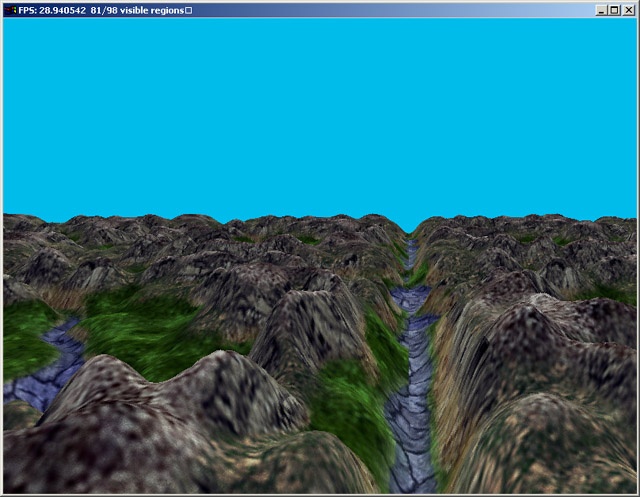 |

Submitted by , posted on 26 June 2003
|
 |

Image Description, by

This image shows my latest terrain engine. I've stolen the landscape and
texture images from here. In this shot
there are 80,000 triangles within the frustum or approximately 2.4M
tris/second, which is not terrific as terrain rendering algorithms go.
However, this engine features smooth LOD. There are no LOD states that get
switched and stuck together, instead a constant level of detail (pixels/poly)
is defined and maintained at all depths. There is no spatial partitioning
system, and there is also extremely little overdraw. There is also a highly
accurate and extremely fast occlusion culling algorithm which allows extremely
fast (negligible time required over and above the tesselation of the
landscape) culling of invisible terrain regions, and terrain-object occlusion
culling in about 10 operations per object bounding volume vertex. There is
also nearly constant (~6% variation) system overhead, and minimal memory
usage. The algorithm scales to all terrain sizes (I've tested it with 256x256
up to 16384x16384 heightmaps) with no performance penalty. And since the
detail is constant at all depths, although there is a lower overall triangle
throughput the triangles that are rendered are used very efficiently which
probably makes up for it.
The above scene took 27 ms to update the landscape. With all the portions of
the process that can be moved to graphics hardware are omitted, the update
time drops to 16 ms. With SIMD and standard optimizations, that could likely
be halved again. Next generation cards that have the ability to do texture
lookups in the vertex transformation stage (ie. compliant with the glSlang
spec) would be able to implement all but an initialization phase and 3 matrix
multiplies per frame as dynamic vertex buffers (giving all the advantages
above but with essentially zero system overhead)
James Gregson
|
|

